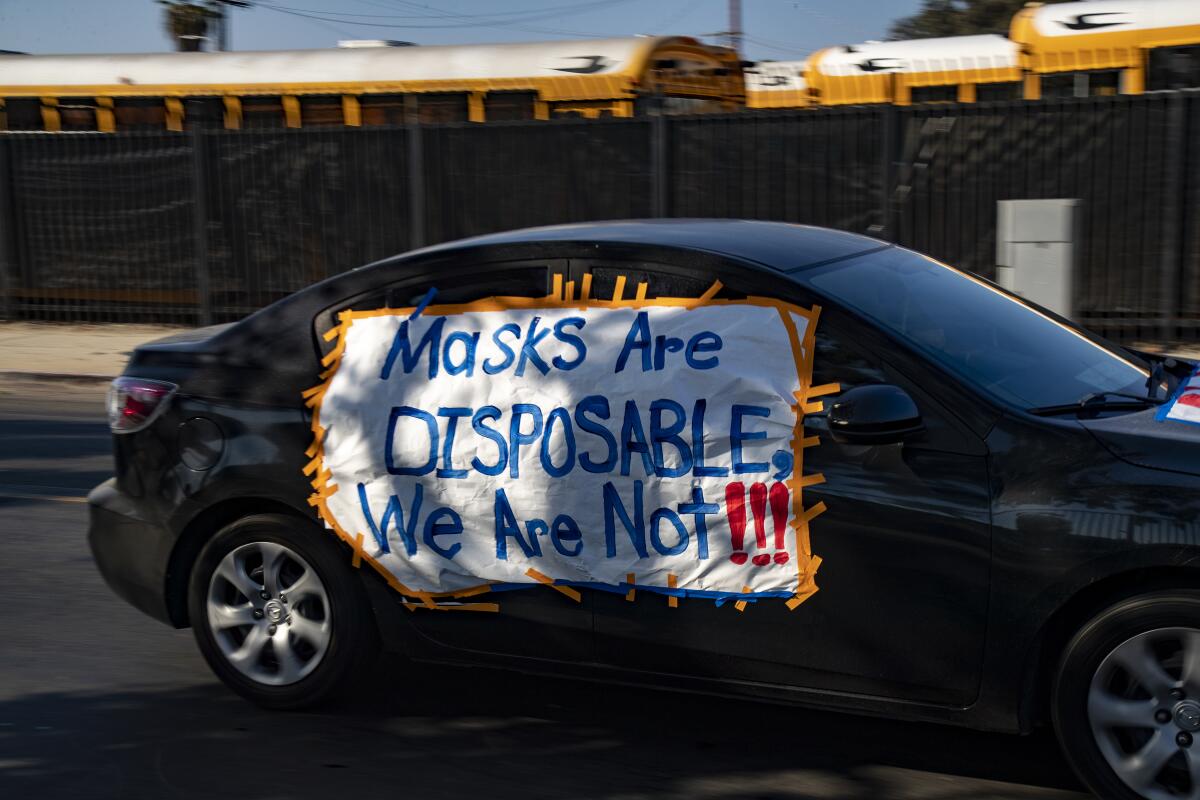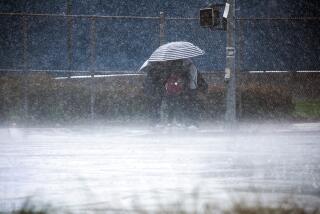The push-and-pull drama over school reopenings reaches fever pitch in L.A. and Orange counties

- Share via
The emotional push and pull over schools intensified Friday as advocates filed litigation to pry campuses open in Los Angeles, even as teachers in Orange County pleaded for them to shut down.
Amid an unprecedented surge in COVID-19 infections and many students faring poorly and failing multiple classes in online learning, it is becoming increasingly difficult to find a tolerable middle ground among school leaders, parents and teachers in the nine-month education crisis that has all but shut down campuses.
Days after the Los Angeles Unified School District announced it was closing all campuses for limited in-person instruction, two children’s advocacy groups asked the state’s highest court to order a partial — but still substantial — reopening to serve the youngest students and those with special needs, such as students with disabilities and those learning English.
In contrast, many school districts in Orange County were able to reopen campuses in the fall when virus rates were subsiding. But with the county’s emergency medical systems near meltdown, teacher union leaders have overwhelming called for a temporary but total campus shutdown, saying the risk to staff, students and their families from COVID-19 is simply too great.
“We are not in a little bubble here,” said Therese Sorey, head of the Irvine Teachers Assn. “The parents of our children work all over the place and our staff lives all over the place.”
In this dichotomy, advocates of each position can bring powerful evidence to bear.
Research is mounting that students have suffered serious harm from the loss of in-person instruction, and L.A. Unified, the nation’s second-largest school district, is among those systems that have moved most gradually and cautiously toward restoring any campus-based services. Its schools also serve communities that are hard hit by COVID-19.
“There is no question that severe learning loss has already occurred, is ongoing, and will lead to irreparable harm for these students,” says the petition filed on behalf of the Alliance for Children’s Rights and the Learning Rights Law Center. “This slow-motion catastrophe — with potentially irreversible and life-long negative consequences for students — can and should be immediately addressed.”
The court filing comes after a Monday decision by L.A. schools Supt. Austin Beutner to order a hard shutdown of all district campuses. He described the public health situation as “extraordinary and quite dangerous,” with infection rates too high to allow for students and teachers to interact safely on campus, even with extensive safeguards in place.
Until that point, L.A. Unified had offered limited in-person tutoring and assessments for students with special needs, reaching less than 1% of 465,000 students in kindergarten through 12th grade.
The litigants characterize L.A. Unified’s dearth of in-person services as unacceptable and illegal, citing education requirements that became law over the summer.
A spokeswoman for the school district declined to comment.
Legislation passed in June preserved funding for school districts at levels similar to the previous year, but also set broad guidelines intended to ensure that students would receive an appropriate education despite the pandemic. Recognizing the limitations of online learning, lawmakers specified that instruction should be conducted in person “to the greatest extent possible” and also that the length of instruction in minutes had to meet state minimum standards.
Up till now, county health guidelines have governed how much instruction is permitted during the pandemic and school districts have the authority to be more restrictive. The litigation seeks to change that at L.A. Unified.
The advocacy groups seek to compel the district to provide as much in-person instruction as permitted under Los Angeles County public health guidelines.
Those directives allow for schools to offer instruction for students with special needs in groups of up to 12. And the total number of students on campus can equal up to 25% of a school’s total enrollment. The guidelines were established to help students in greatest need, including those with disabilities, English learners and those who are particularly struggling with distance learning.
In addition, schools can apply for waivers to bring back their youngest — transitional kindergarten through second-graders — who are least able to learn via Zoom and other online platforms.
“While distance learning is a challenge for everyone … for some students, it is simply impossible,” said Alex G. Romain, a partner at Milbank LLP, which filed the suit on behalf of the organizations in conjunction with two other law firms.
The state legislation also requires school districts to address learning loss whenever possible through in-person classroom-based instruction, and L.A. Unified has failed to do that, Romain said.
The lawsuit alleges that the school district could have taken steps to resume some in-person classes as early as September with safety protocols in place. The school year began in mid-August and the district has previously said it began its one-on-one tutoring program in October.
Ariel Harman-Holmes, 40, took time off work as a lawyer to stay home with her children ages 2, 6 and 8. Her 8-year-old, who is autistic, struggles with the online format. The internet glitches are distracting, and the Zoom classes can lead to a sensory overload. She said she has tried to get him assessed and placed in a specialized program, but the process was delayed by school closures. She said his writing has regressed.
“He needs more than a screen,” she said. “He can’t learn this way, he just can’t.”
Sorey, of the Irvine Teachers Assn., fully agrees that students need to be in class in person, but not right now.
Her union joined with nearly every other teachers local in Orange County calling for a temporary shutdown of district campuses that have remained open during the surge.
District officials in Brea Olinda Unified announced a return to to full-time distance learning last Monday and the La Habra City School District made a similar call effective Dec. 3 and continuing through winter break, said Ian Hanigan, chief communications officer for the Orange County Office of Education.
Other district leaders, including those in Irvine Unified, have insisted they can continue to operate safely. Infections, they said, are not spreading within schools — even though schools have reported cases.
Since Aug. 16, there have been 658 cases reported by schools, according to the county’s health department. Over that period, campuses were gradually reopening, with the early grades typically returning sooner.
Sorey said parents are not necessarily reporting health information to districts, so it’s been difficult to get a full understanding of the prevalence of the infection at schools. But they are telling teachers about risky activities, including birthday parties, family travel and club sports. And some school systems, she said, have been more transparent in posting information than others.
Efforts also are underway at the state level to nudge campuses back into operation, but only when health conditions have improved.
A group of Democratic state legislators is advocating for schools to begin planning for in-person instruction next semester. On Monday, Assemblyman Phil Ting (D-San Francisco) introduced a bill that would require educational agencies to establish in-person instruction soon after allowed to by public health authorities.
In a statement, Ting, who is a father of school-age children, said he is concerned about students who are falling behind because of “our sole reliance on remote teaching.” Low-income students at public schools are bearing the brunt of the closures, as some private schools have already reopened, worsening achievement gaps, he said.
“Schools in other states and countries have prioritized in-person learning during COVID-19 and have done so without major outbreaks. California ought to follow that path,” Ting said.
More to Read
Sign up for Essential California
The most important California stories and recommendations in your inbox every morning.
You may occasionally receive promotional content from the Los Angeles Times.















